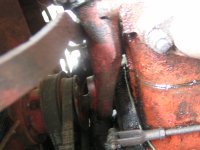No, that's the fan bracket water outlet. Note the above pictures, of the other outlet (actually, the inlet) with pulley, that goes to the bottom radiator hose. I'll correct myself on the model of that engine. It's a Model U2-55 on mine. The U-2 unit was 113 cubic inches, when mine was overhauled by an IH dealer, the PO had an oversized bore kit put in it, making it 123 cubic inches, like in the Super A, and C series. The "55" designates it was mounted on a 55-T baler. Look at the lower left of the engine, where the radiator hose attaches to the radiator. It may only have an elbow like mine. I've worked mine pretty hard pulling a 4' rotary cutter in 3'-4' high weeds and grass, and pushing fill material with a front mounted blade. and got it pretty warm, but not overheated. If the radiator is clean inside, and out, and fan belt properly adjusted, more than likely, you won't have any problems.
As luck would have it, the engine couldn't have stopped at a better place. Look close at the fan assy. in the picture, and note the round headed screw in the space ahead of the fan belt sheave, and the fan itself. That screw needs to be removed, and oil pumped in occasionally, to lubricate the fan assembly. The correct procedure to do that, is to turn it a bit towards you in that picture, until it it horizontal. Remove the screw, then with an oil can pump SAE 30 non-detergent oil in there, until it runs out. Then I place a shop rag below the assembly, then turn that hole straight down, until the excess oil stops running out. Then turn the fan until the screw hole is back to horizontal level, or where you can get to it easily, and replace the screw, and snug it. From the picture, it apperas to be in good shape, and no oil coming out the back. These units aren't rebuildable, so this simple procedure can save you time and money down the road.
I do this to all of mine during the Spring oil change, getting ready for the summer. Probably not required that often, I just do it then, so I don't overlook it, if done every few years. I've attached a picture of the clutch housing on mine, with the model number on it. It's being used as an engine stand for another C-113 engine, that is a work in progress here.
View attachment 714449
